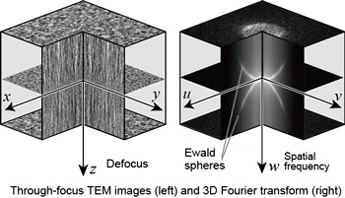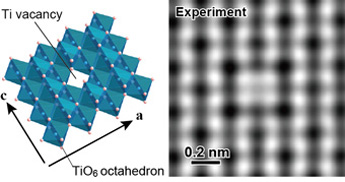Assessment of TEM performance using 3D Fourier transform
 |
Low acceleration voltage in TEM has various advantages such as low knock-on damage and high sensitivity. Thanks to spherical aberration correctors, high-resolution can be achieved even in a low-acceleration voltage, e.g., 80 kV. Performance of TEM systems are usually checked using two-dimensional Fourier transform, i.e., diffractogram; however, the accurate assessment of TEM performance is not straightforward, because of the strong interaction between slow electrons and atoms. We have performed three-dimensional (3D) Fourier transform of through-focus TEM images and the liner-imaging term, which correctly reflects a crystal structure, is measured. See details in papers [1, 2]. |
| [1] K. Kimoto et al. Ultramicroscopy, 121 (2012) 31. [2] K. Kimoto et al. Ultramicroscopy, 134 (2013) 86.. |
Application of low-voltage TEM for oxide nanosheet
 |
Low-voltage high-resolution TEM has been applied for various nanomaterials, such as graphene and MoS2, to analyze their microstructures. Oxide nanosheets are promising nanomaterials; for instance, titanium oxide nanosheet is used for self-cleaning coating because of its photo-catalytic function (see details about oxide nanosheets on Dr. Sasaki's website. However an atomic TEM observation of an oxide nanosheet is challenging because of serious beam damage. We have successfully visualized atomic arrangements of a titanium oxide nanosheet using low-voltage TEM and low-dose technique. See details in papers [3, 4]. |
| [3] M. Ohwada et al. J. Phys. Chem. Lett.2 (2011) 1820. [4] M. Ohwada et al. Scientific Reports 3 (2013) 2801. |